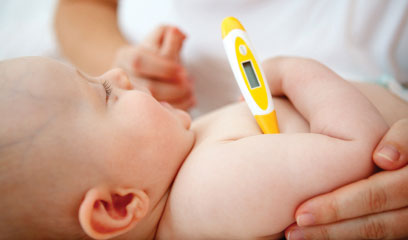Fever in babies is always a concern for parents, as it is a sign of medical condition occurring which often requires treatment. If the body temperature is higher than 37.5 degrees Celsius, it is considered as fever. Any fever between 37.5 and 38.2 degrees Celsius is considered as low-grade fever, while any fever over 38.2 degrees Celsius is considered as high fever. What to do in cases of low-grade fever in babies?

What If Your Baby Has a Low-Grade Fever?
Have you noticed low-grade fever in your baby? If yes, but your baby is eating, drinking and playing as he/she usually does, there is no need to worry. You will just need to pay a close look to that fever and make sure it does not turn into a high-grade fever. Also, pay attention to any other signs that may become noticeable in the meantime. The following remedies can help relieve your baby's low-grade fever.
1. Fluids
Your baby is more prone to dehydration in cases of low-grade fever. Ask your doctor if oral rehydration fluids are necessary. These oral rehydration fluids will replace the necessary electrolytes. Also, make sure to feed your baby normally as you used to.
2. Bath
A lukewarm bath might be helpful when reducing your baby’s fever. Bathe your baby for about 5 to 10 minutes. If your baby starts shivering while in a lukewarm bath, end the bath immediately. If your baby starts shivering, the temperature will just get worse as normally the body produces heat while shaking. Dress your baby in light clothes after a lukewarm bath in order for him/her to be as much comfortable as possible.
3. Rest and Sleep
Resting and getting enough sleep might be helpful every time your baby is not feeling well. Monitor closely low-grade fever in babies at the same time.
- The room temperature should be about 21.1 to 23.3 degrees Celsius. It should not be too cold, nor too hot.
- Dress your baby in light clothes so he/she can be able to lose heat easily through the skin. If your baby starts shivering, cover with a blanket.
- Use a cool, damp washcloth to eliminate your baby’s fever. Put the cloth on your baby’s forehead while resting. It is forbidden to use cold water or ice as it will just make the fever get worse.
- You can also rub the soles of your baby with warm oil. This will help your baby relax and make him/her sleep more comfortably. A good sleep will speed up the recovery process.
4. Medication
In general, in cases of low-grade fever in babies, no medications are recommended as long as the baby keeps eating, drinking and playing the same as before the fever started. However, when the baby gets cranky and refuses to eat or drink, medications are needed.
Consult your healthcare provider before using any medications to reduce fever. Acetaminophen is recommended for all babies regardless of their age, while ibuprofen is recommended for children over the age of 6 months old. Aspirin is not recommended for children under the age of 19 years old, due to the possibility of the development of a life-threatening condition known as Reye’s syndrome.
When to Call the Doctor for Baby’s Fever
If you are a new parent, it is normal for you to worry whenever your baby has a fever. As you get more experienced, you will know how to handle a fever even without visiting a doctor’s office. However, every time that you are concerned about the health of your baby, call or visit your doctor for an advice, regardless how high the temperature is.
You already know what to do with low-grade fever in babies. Call the doctor in the following cases:
- Your baby is younger than 3 months old and has a temperature higher than 38 degrees Celsius.
- Your baby is 3 months and older and becomes cranky and refuses to eat or drink.
- The fever persists for more than 24 hours or gets higher than 40 degrees Celsius. Call your doctor immediately, regardless if your baby has any other signs and symptoms or not.
- Your baby is between 3 and 6 months old and has a fever of 38.3 degrees Celsius.
- Your baby is more than 6 months old and has a fever of 39.4 degrees Celsius.
- Your baby, except low-grade fever, has also vomiting, diarrhea, earache, loss of appetite, cough, sleepiness, etc.
- You notice that your baby is pale or flushed.
- You notice that your baby has fewer wet diapers than usual.
- You notice a skin rash. Small red spots on the skin which tend not to change color when pressured can be a sign of a bacterial infection which requires proper medical treatment.
- You notice difficulties breathing even after clearing the nose. It could be a sign of bronchiolitis or pneumonia which requires proper medical treatment.
